2007 VOLKSWAGEN GOLF door lock
[x] Cancel search: door lockPage 239 of 444
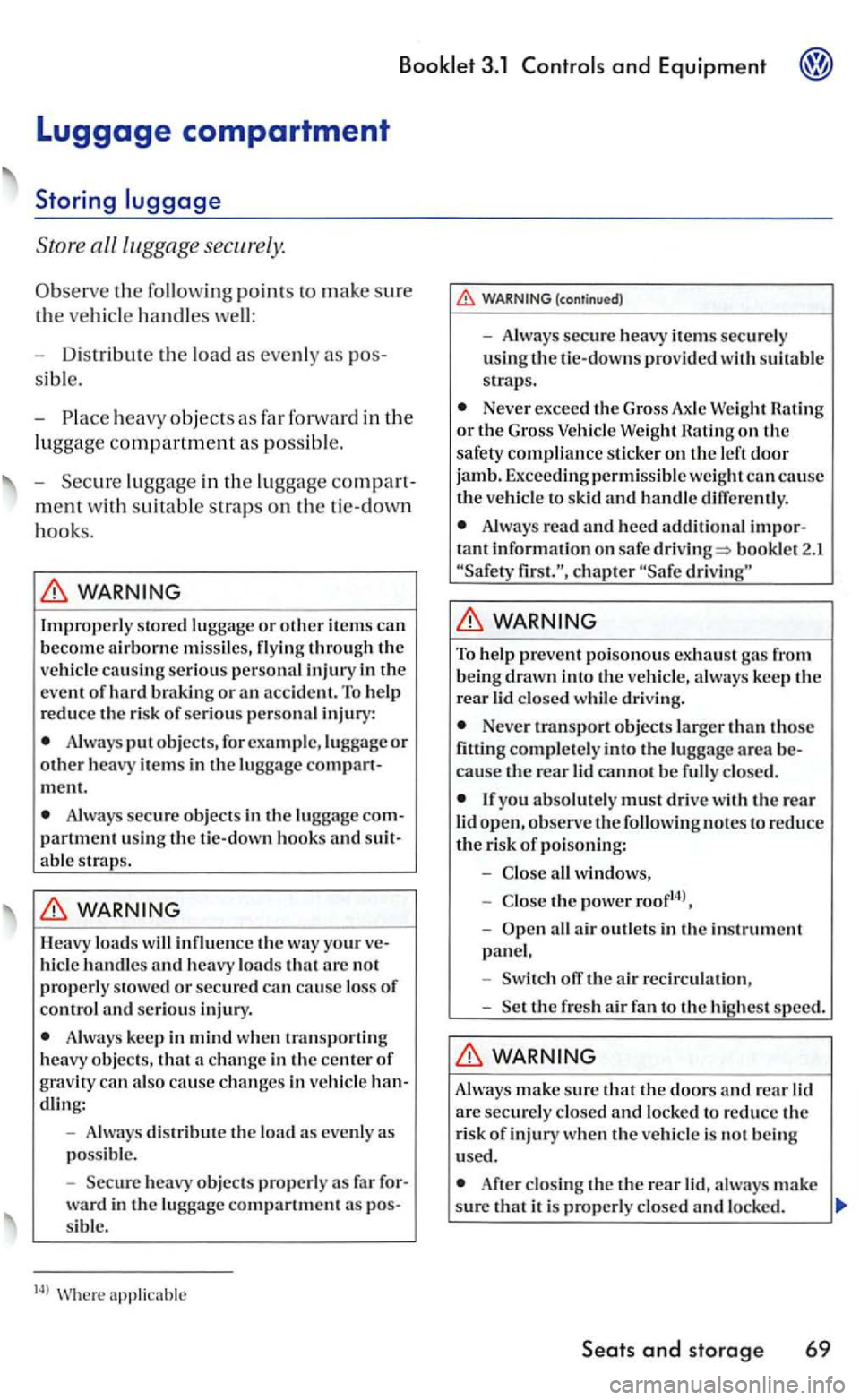
and Equipment
the following points to make sure
the ve hicl e handles well:
- D is tribute
the load as even ly as
heavy objects as far forward in the
lu ggage compartment as possibl e.
-
luggage in the lug gage compart
men t w ith suitable s traps o n the tie-down
hooks.
WARNING
Improperly stored luggage or other item s can become airborne mi ssi les, fly ing through the
ve hicl e ca using seriou s personal inju ry in the even t of hard braking or an acc ident. To help
reduce th e risk of serio us personal injury:
Always put objec ts , for example, lu ggage or other heavy item s in the lugg age compartment.
Always secure objec ts in the luggag e partment usi ng the ti e-down hook s and suit able straps.
WARN ING
Heavy loads will influ ence the way your hicl e handles and heavy loads that arc no t properly s towed or secured serious i njury.
Always keep in mind when transp o rtin g
heav y objec ts, that change in the center of g ravity can also cause ch anges in vehicle
eve nly as possible.
- Sec
ure heavy objects prop erl y ward in the compartment sibl e.
Where applicahlc
(con tinued)
- Alwa ys secure heavy item s securely
u sing the ti e-downs provided w ith suitable
straps.
Neve r exceed the Gro ss Axle Weight Rating or th e G ross Vehi cle Weig ht Rating on the safety compliance sticker on th e
Always read and heed add itional tant information on safe booklet 2.1 chapter driving"
WARNING
To help prevent po isonous exhaus t gas from being drawn into the veh icle, always keep th e rear lid
Never transport objec ts larger than tho se
fittin g co mpletel y into th e luggag e area cause the rear lid cannot be fully closed.
Lfyo u absolu te ly must drive wi th the rear lid open, observe the following notes to reduce the risk or poi soning:
-
the pow er roof14l,
-all a ir o utle ts in th e in strument pane l,
- Switch
the air recirculation ,
-
Set the fr es h air fan to the highe st sp eed.
WARNING
A lwa ys make sure that the doors and rear lid are securel y clo sed and locke d to red uce the
risk of in jury when the vehicl e is not bein g
u sed.
locke d.
Seats and storage 69
Page 254 of 444
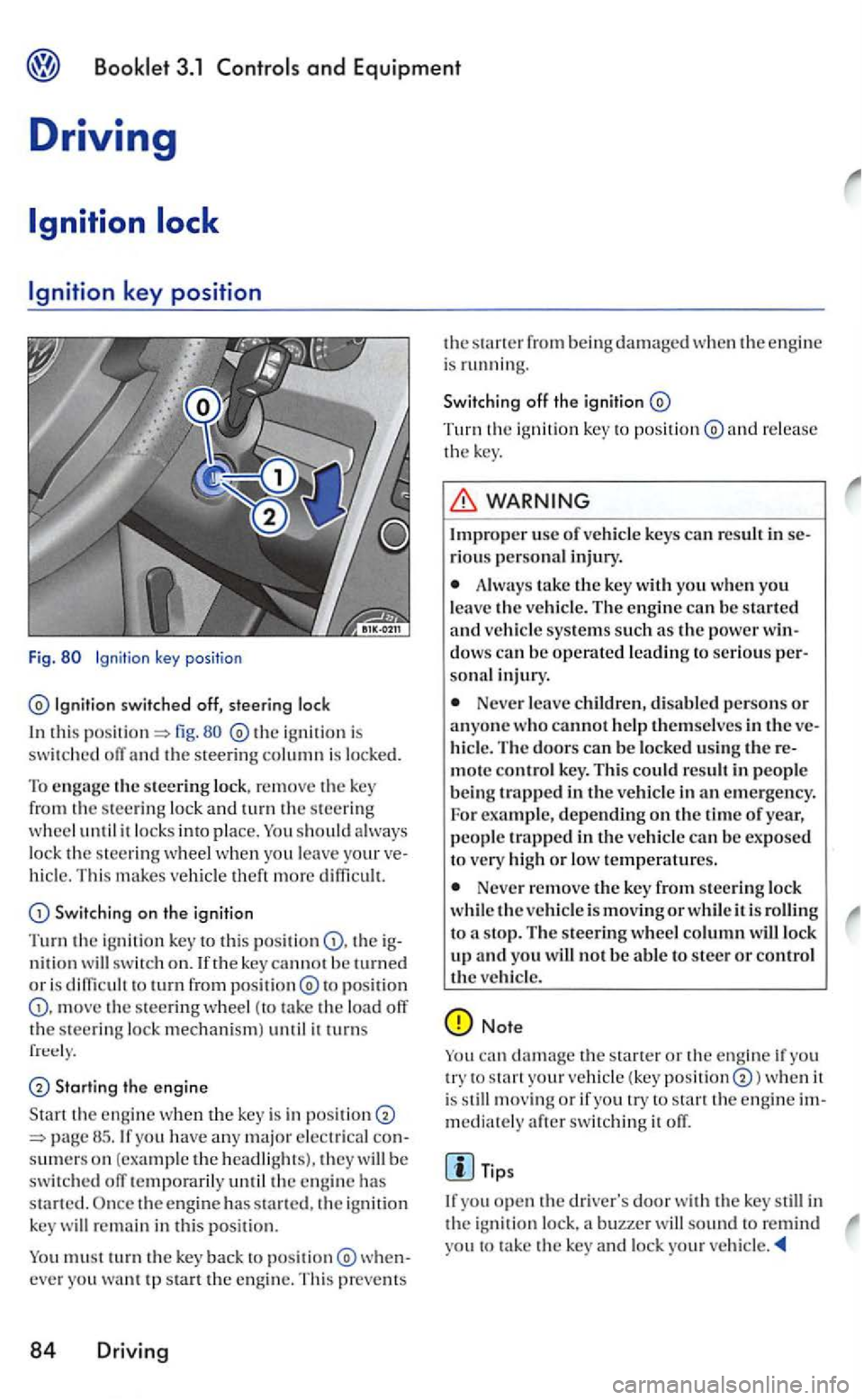
Booklet 3.1 Controls and Equipment
Driving
Ignition
key position
Fig.
switched off, steering loc k
this fig. ig niti on i s swit c h ed off an d the ste erin g column is locked.
T o engage th e s teering lock . remove the key
from th e s teering lock a nd turn the s teerin g wheel u ntil it locks into place. You sh o uld lo ck th e s teering when you leave vehicl e. T his m akes ve hicle th eft m ore diffi cu lt.
Swi tch ing on th e ignition
Turn the ignition key t o this th e ig
n iti o n sw itc h on. lfth e key cannot be turned o r i s to turn from to p osition th e steering wheel (to tak e the load off the s teering lock mechani sm ) until it turns
Starting the e ng in e
Sta rt th e e ng in e when the key is in posit io n have any m ajo r e lectri cal consumers on (example the headli ghts). they
re mai n in thi s posi tion.
Y o u
must turn th e key back to
Tu rn the ig ni tio n key to po sition re lease
t h e key .
usc of vehicle ke ys can result in se
r iou s personal in jury.
Alwa ys take the key with yo u when you leave th e ve hicle. The engine can be starte d
and vehicl e sys te m s such a s the pow er windows can be operate d leading to serio us persona l injury.
N ever leave children, di sabled perso ns or anyone who ca nnot help themselve s in the ve
hicle. The doors can be locked u sin g t he re
mote con tro l key. This could res ult in people b e ing trapped in the ve h icl e in an emergen cy .
For example, depending on the tim e of year,
peopl e trapped in the vehicle can b e exposed to very high or lo w temperatures.
Never re m ove the key from steering lock
w hi le the vehicl e is movi ng or w hil e it is to a s top. The s teerin g wheel column will lock up and yo u w ill not be able to steer or contro l the vehicl e.
Note
yo u try to s tart your ve hicl e (k ey position when it
is still mov ing or if yo u try s ta n the en gin e immediate ly after switc h in g it off.
yo u open th e in
the i g nit ion lock, buzzer yo u to take the key and lock your ve hicle.
Page 265 of 444
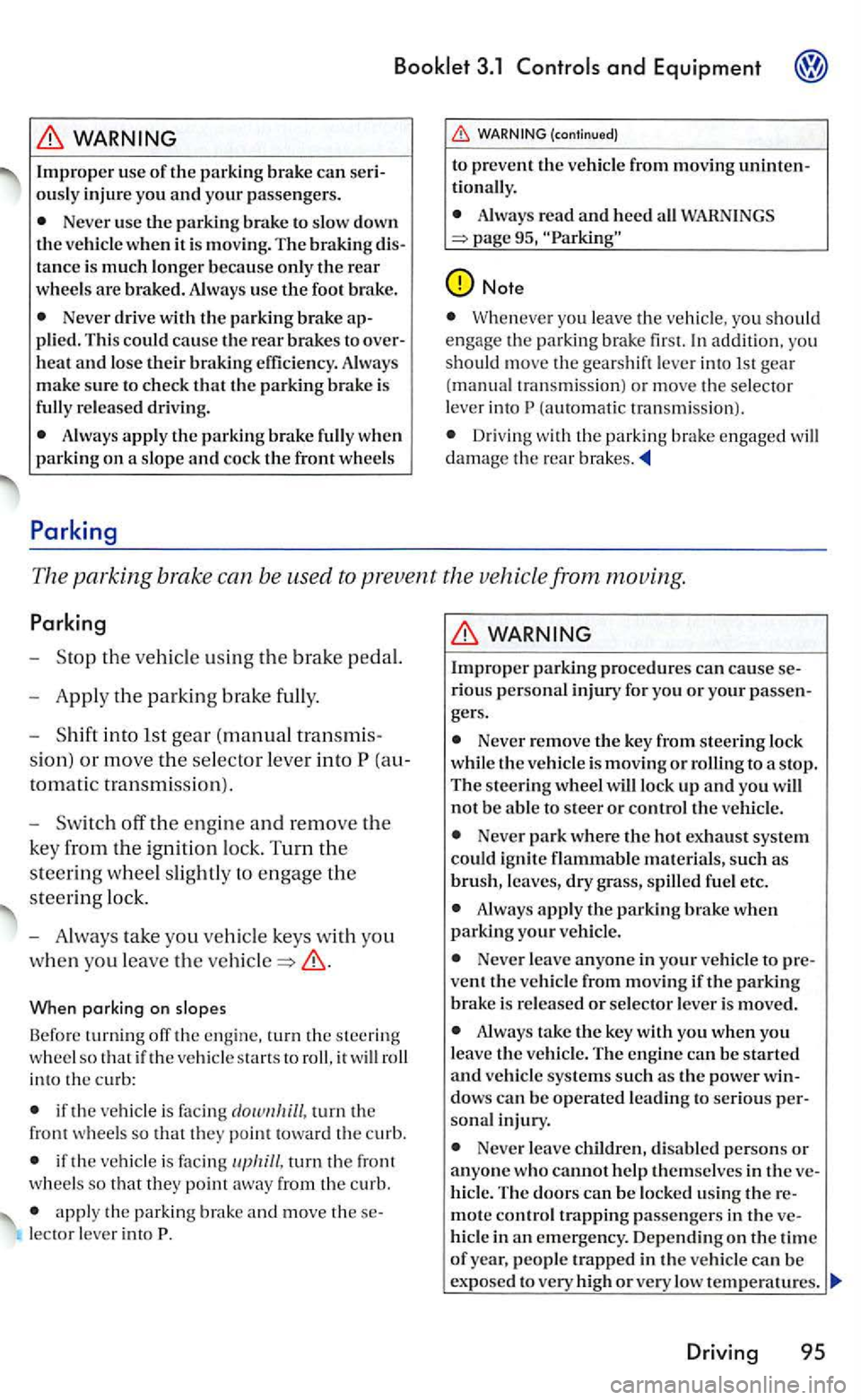
Booklet 3.1 Controls and Equipment
WARNING
Improper use of the parking brake can seri
ousl y injur e yo u and your passenge rs.
Neve r use the parking brake to slo w down
th e ve hicle when it is mov ing. The braking tanc e is much longer because only the rear wheel s are braked. Alwa ys use the foot brake.
Neve r drive with the parking brake plied. This could cause the rear brakes to overheat and los e their braking efficiency. Always
make sure to check that the parkin g is
fully re le a sed dri vin g.
Always apply the parking brake fully when
parking on a slope and cock the front wheels
Parking
(co ntinue d)
to prevent the vehicle from moving
Always read and h ee d WARNINGS
Whe never you leave th e veh icle, you should engage the parkin g
(aut om ati c tra nsm ission) .
Driving w ith the parking brake engaged will damage the rear
The parking bra ke can be used to prevent th.e vehicle from moving.
Parking
-the vehicle using the brake
-Apply th e parkin g brake full y.
-
into lst gear (m anual transmi s
sio n)
or move the se lector lever into
When parking on slo pes
Before turn ing off the engine, turn the steering
w hee l so that if th e vehicle starts roll, it will roll into the curb:
if the vehicle is facing turn the
f ront wheels so that they point toward the curb.
if th e veh ic le is facin g
apply the parkin g brake and m ove theselector leve r into
WARNING
Improper parki ng procedures can cause riou s personal injury for yo u or your passe n
gers.
Neve r remove the key from steering lock
while the ve hicl e is moving or rolling to a s top . The steering wheel will lock up and yo u will not be abl e to steer or contro l th e vehicle.
Neve r park where the hot exhaust system could ig nit e flammable materi als, such as brush, leaves, dry g ra ss, spill ed fue l e tc.
A lwa ys apply the parking brake when parking your vehi cle.
Neve r leave anyone in your vehi cle to vent the ve hicle from movin g if the parking brake is released or selector lever is moved.
Always take th e key with yo u when you leave the vehicle. The engin e ca n b e started and veh icle syste m s s uch as the powe r dows can be operated leadi ng to serious sonal injury.
Neve r leave childre n, disabl ed person s or anyone w ho cannot h elp th e mselves in the hicle. The doors can be locked using th e re-
m ote control trapping passe ngers in the h icle in an emerge ncy . Depending on the tim e of year, peo ple trapped in th e vehicle can be ex po sed to very high or very low temperatures.
Driving 95
Page 269 of 444
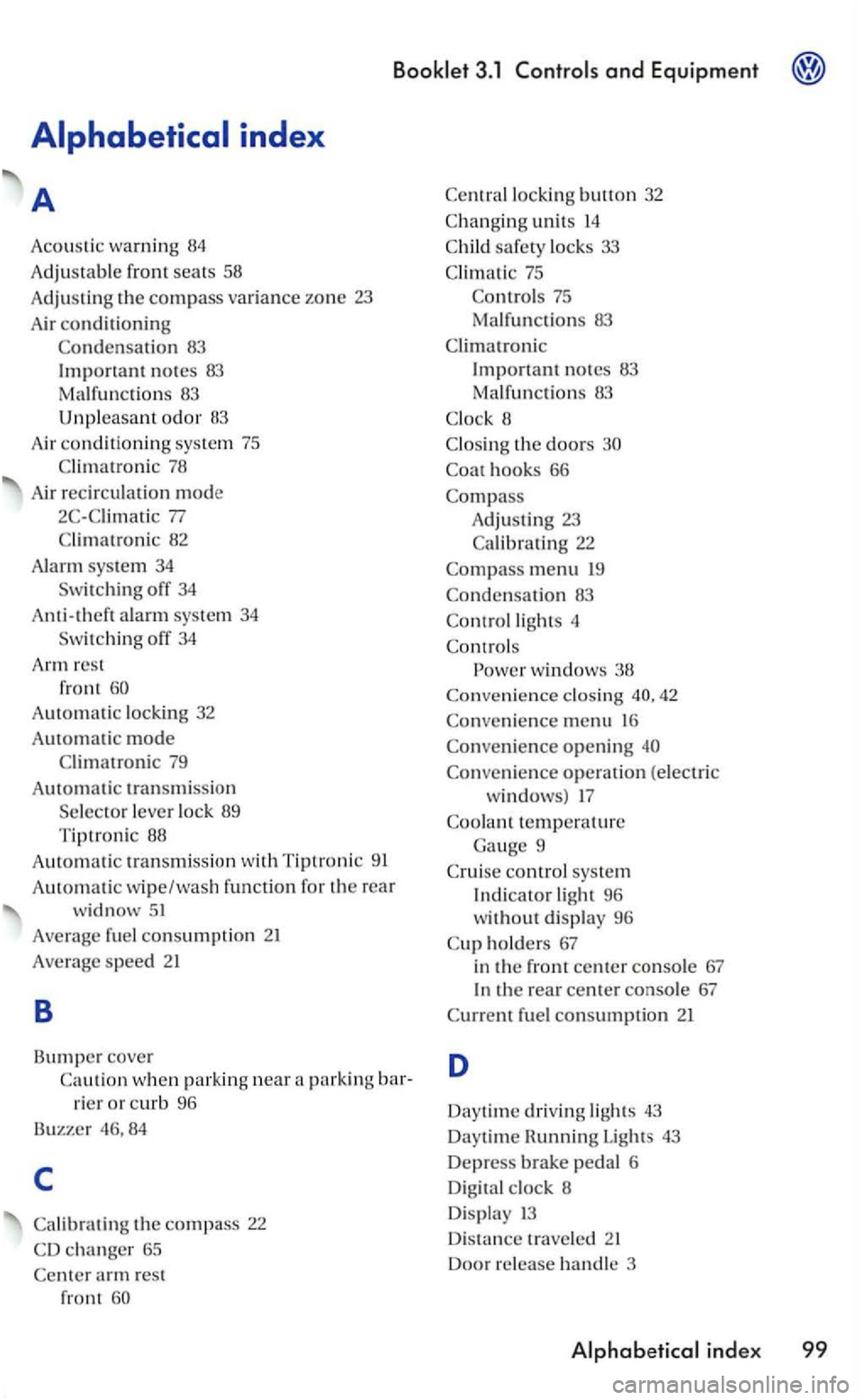
3.1 and Equipment
Average fuel consumpti on 21
Average spe ed
B
Bumper cove r
Ca ution when parkin g near a parking
rier or curb 96
Buzzer 46,
84
c
Calibrating the compass 22
CD changer 65
Center arm rest
fro nt
Child safety loc ks 33
Clima tic 75
Controls 75
Malfu nctions 83
Climatronic
Important notes 83
Ma lfunc ti
ons 83
C
lock 8
Clos ing the
doors
Coat hooks 66
Compass
Adjusting 23
Calibrating 22
Compass menu 19
Condensation 83
Control lights 4
Controls
w indows 38
Convenience closi ng
D istance tra veled
Doo r re lease handle 3
ind ex 99
Page 270 of 444
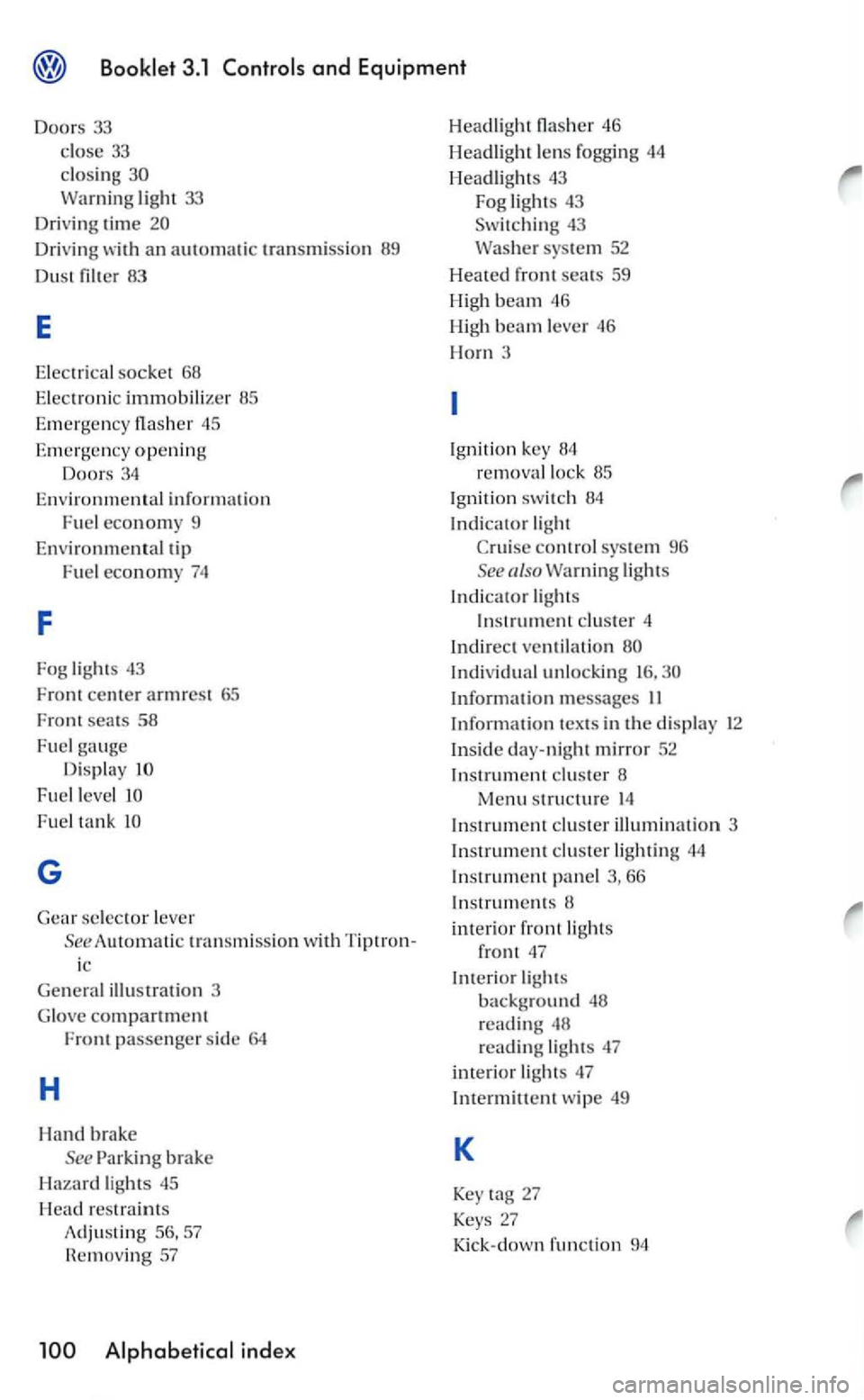
light 33
Dri v
ing time
Dri vin g wi th an t rans missio n 89
Du st filter 83
E
E le c trical socket 68
E l
ectro n ic immobilizer 85
Emergency fla sh er 45
Emergen cy opening
Doors 34
Env
ironme n tal informatio n
Fuel econom y 9
Environmen tal tip
Fuel economy 74
F
Fog light s 43
Front center armrest 65
Front seats 58
Fuel gauge Display
Fuel level
F u el ta n k
G
Gear se lector lever
See A
utomatic trans m ission wit h Tip tron
ic
illu stration 3
G l
ove compartment Front passenger sid e 64
H
Hand brake
See Parking brake
Hazard lights 45
H
ead restraints
Adjusting 57
R em
oving 57
46
Headlight lens fogging 44
Headlights 43
Fog
lights 43 Switching 43
syste m 52
H
eated f r ont seats 59
H ig h
beam 46
High
beam lever 46
Horn 3
I g niti on key
removal lock 85
I gni ti
on switch 84
Indicator light
control sy stem 96
See also
Indi vid ual unlocking
In formati o n messages
66
In struments
inte rio r front lights
front '1 7
Interio r lights
backg round 48
reading 48
readin g lig ht s 47
imerio r ligh ts 47
In te
rmitt ent wipe 49
K
Key 27
Keys 27
Kick-down functi on 94
Page 299 of 444
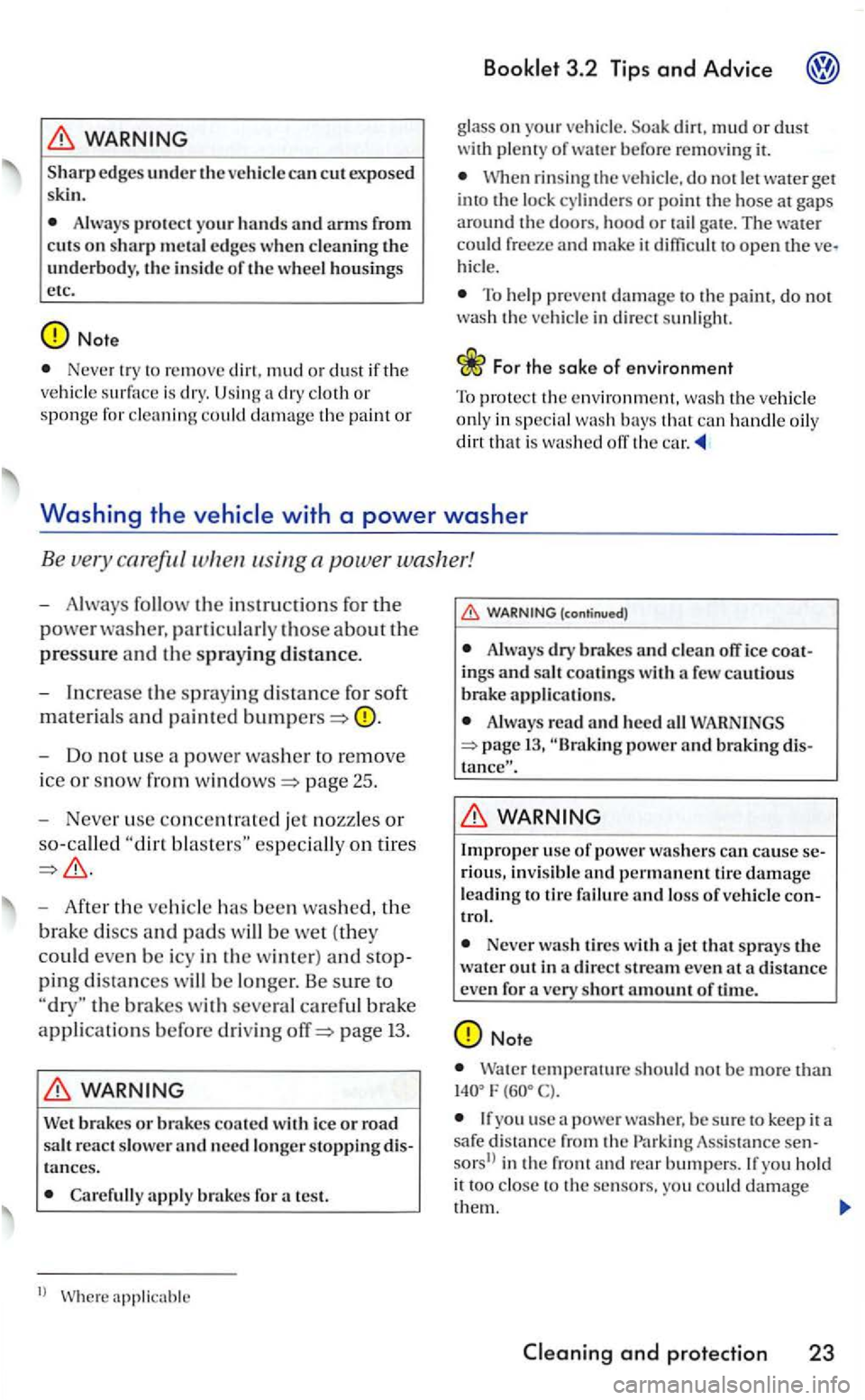
edges under the vehicl e can cut exposed
ski n.
Alway s protect your hands and arms from cuts on sharp m etal edges when clea ning th e underbody, the inside of th e wheel housin gs
etc.
Never try to remov e mud or dust if the vehicle dry . a dry cloth or
sponge fo r cleaning could damage th e paint or
3.2 Tip s and Advice
glass on your vehicle . dirt . mud or dust with plent y of wate r before removing it.
When rinsing the vehicle. do no t let water ge t
int o th e lock cylinders or point the hose at gaps
around the doors. hood or tail gate. The water could freeze and make it difficult to open the hicle.
To he lp preve nt damage to th e pai nt, do not was h the vehicle in direct sunl ight.
F o r th e sake of environment
To protect the environme nt. wash the vehicle
only in specia l was h bays that c an handle oily
d irt that is wash ed off th e car.
- Do nor use a power washer to remove
ic e
or snow page 25.
- Neve r use concentrated jet nozzles or
so-called
- After ve hicl e has been washed, the
brake
dis cs and pads will be we t (they
could even be icy in the win te r) and
th e brakes with seve ra l care ful brake
application s before drivin g page 13.
WARNING
brakes or bra kes coa ted with ice or road salt react slower and n eed longer stoppin g tances.
Ca re full y apply brake s for a test.
1
l ap plicab le
Always dry and cl ean off ice ings and salt coatings with a few cautious brake applicati ons.
Always rea d and heed all power and braking
WARNING
Improper usc of powe r was he rs ca n cause rious , in vis ible and perm an ent tire damage leading to tire failur e an d loss of ve hicle trol.
Never wa sh tire s wi th the water out in a direc t stream even at
temperature sh o uld not be more than F
If yo u use power wash e r. be sure to keep it a
sa fe d istance from the sors' > in the front and rear bumpers . you h old
it too to the sensors, you could damage
them.
and protection 23
Page 302 of 444
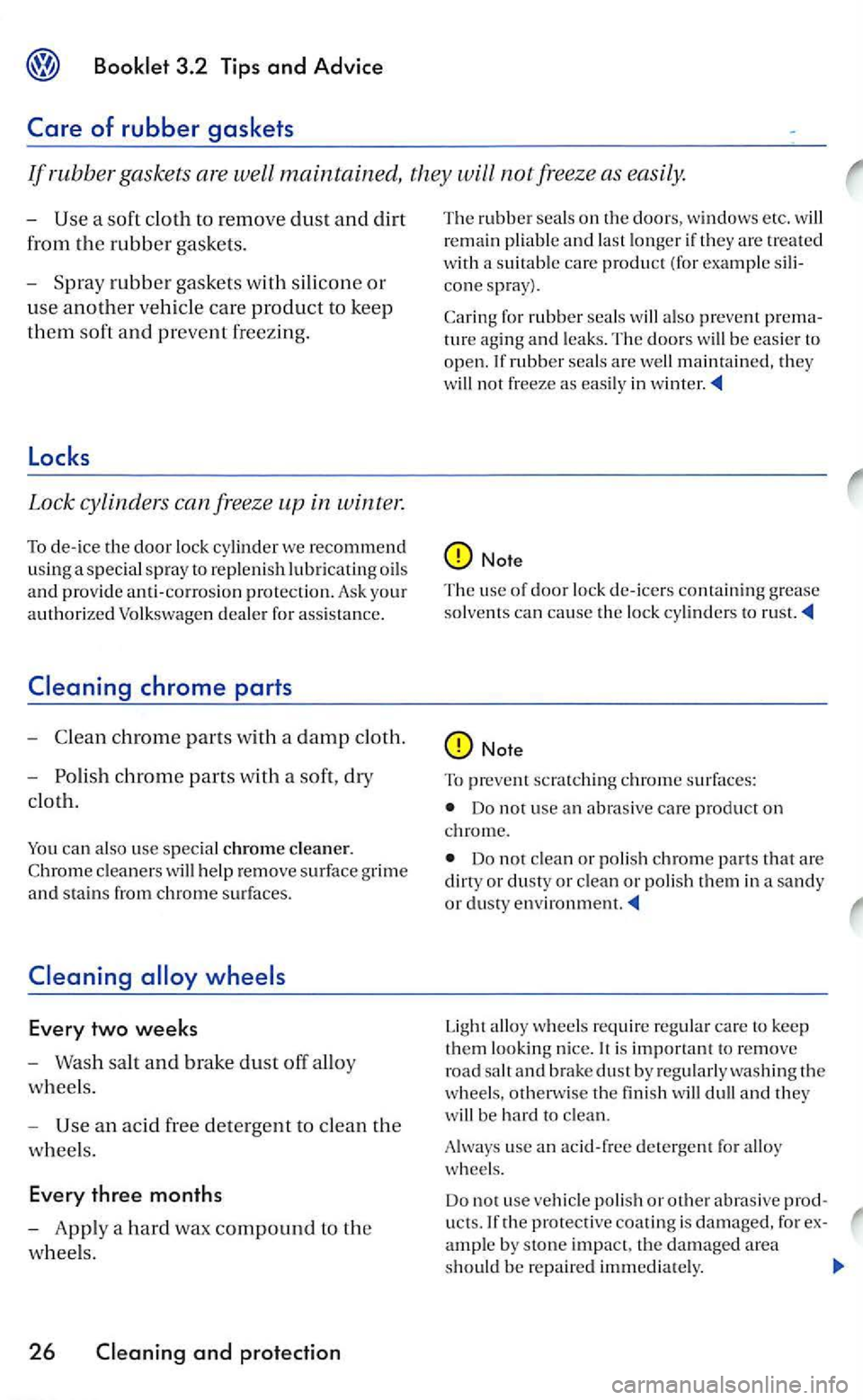
a soft cloth to re m ove dust and d irt
from
the rubber gaskets.
- Spray
rubber gaskets with silicone or
u
se another veh icle care product to kee p
them soft and p revent freez ing.
Locks
Lock cylinders can freeze up in winter.
To de-ice the door lock cylinder we recommend
using a sp e cia l spray to repl enish lubricatin g oils and pro vid e an ti- co rro sio n pro tect ion. Ask you r
authorized Volkswagen dea le r for ass istance.
ca n also use sp ecia l ch ro m e clea ner. cleaners will he lp remove surface grime and sta ins from chrome surface s.
an acid free dete rgent to clean the
w h
eels .
E very three months
- Apply a hard wax compound to the
w
heel s .
26
for rubber sea ls w ill also prevent pre mature aging and leaks. The doors will be easier to open. rubber seals are well maintained, they
will not freeze as easi ly in winter.
Note
The use of door lock de-icers contai ning grease
solvents can cause the lock cylinders to rust.
Note
To prevent scratching c hrome surface s:
Do not use an abrasive care prod uc t o n
chrome.
Do not clea n or polish chrome pa rts that are
dirty or dusty or clean or polis h them in a sandy or dusty environment.
Light alloy wheels require reg ular care to keep them look ing nice. is impor tant to remove
road salt and brake dust by regularly wash ing th e
wheels, other w ise th e finish will be hard to clean.
Always use
an acid-free detergent for alloy
w heels.
Do not use vehicle polish
or other abras ive prod
ucts. the protective coating is damaged, for example by stone im pact. the damaged area should be repaired immediately .
Page 311 of 444
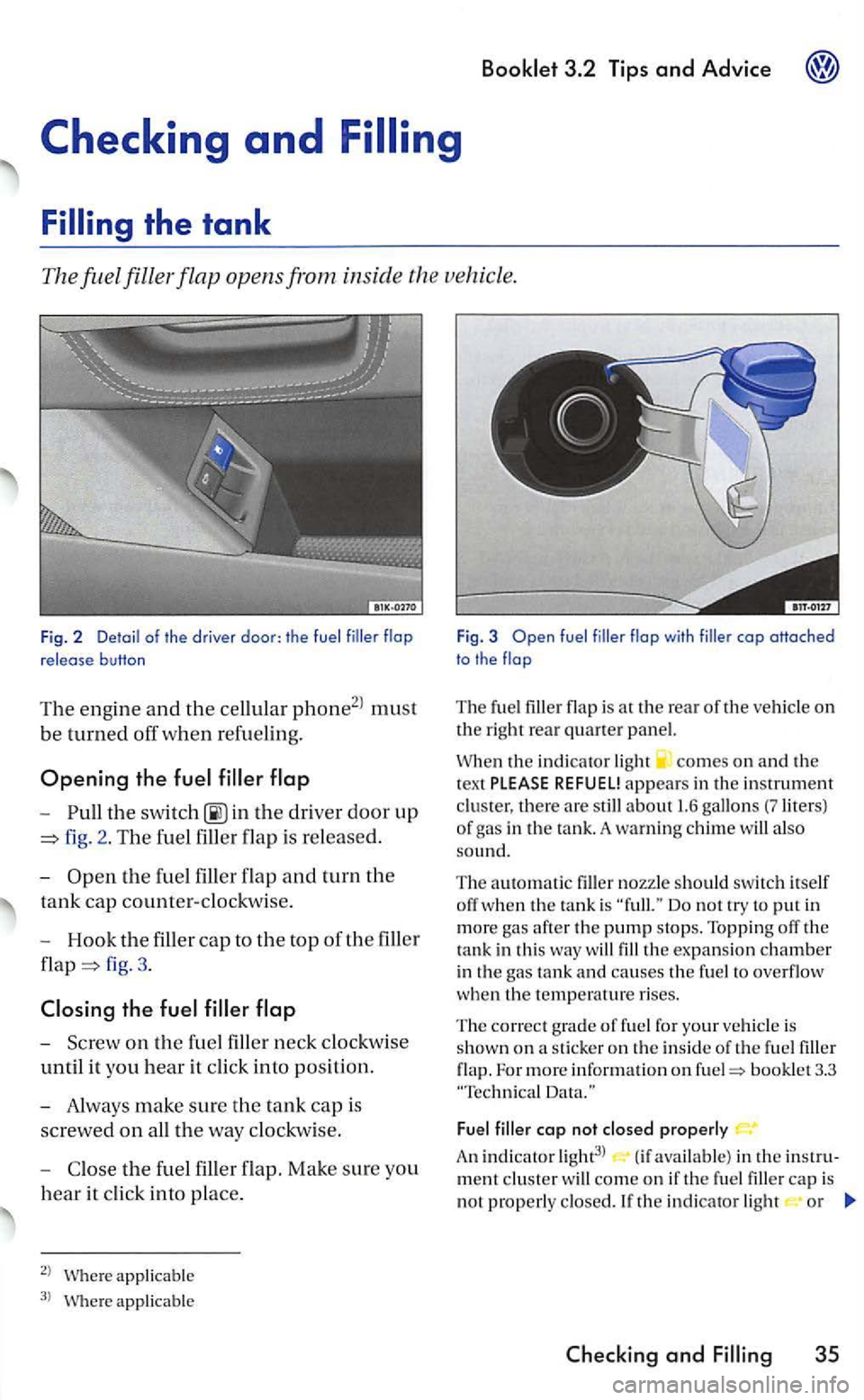
-in the driver door up
fig. 2. T he fuel filler flap is re leased.
-
Open t h e f uel filler flap and turn the
tank cap counter-clockwise.
- Hook
the fille r cap to the top of th e filler
fig. 3.
the
-Screw o n the
applicable
applic able
Fig . 3 fue l flop with cop oHoched
to the
The fu el flap is a t the rear of the vehicle on the right rear quarter panel.
th e indi cator light comes on and th e
t ex t PLEASE REFUEL! appears in the in strume n t
clu ster, there are s till ab out 1.6 gallo ns (?liters) of g as in the tank. A warning ch im e will also so und.
The automatic nozzle shoul d swi tc h itself off w hen the ta nk is
the expansion chamber
i n the gas ta nk and causes the fuel to overflo w when the temperature rises.
T
he correct g rade of fu el for your vehicle is
show n on a stick er o n th e inside of the fu el flap. For m ore informatio n on bookle t 3.3
Fuel filler cop not closed prope rl y
A n in d ic a to r light3l (if available) in the
Checkin g and 35